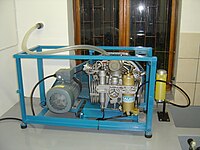
Photo from wikipedia
Abstract In this study, the nozzle characteristics of zoned and staged double P-type gas-fired radiant tube were improved to optimize combustion efficiency. A three-dimensional finite element model was established, and… Click to show full abstract
Abstract In this study, the nozzle characteristics of zoned and staged double P-type gas-fired radiant tube were improved to optimize combustion efficiency. A three-dimensional finite element model was established, and a grid-independence study was conducted to guarantee the accuracy of the calculation results. Corresponding experiments were designed to prove the reliability and accuracy of the simulation model. Then, the developed mode was used to determine the flow field characteristics of the zoned and staged gas-fired radiant tube. Moreover, the gas and wall temperatures were calculated by altering the gas speeds in the main and branch tube nozzles respectively. The effects of nozzle gas speed on the radiant tube were compared. Results showed that increasing the air speed of the main tube nozzle could decrease the maximum temperature and the wall temperature difference, improve temperature uniformity, and slightly increase thermal efficiency. Increasing the air speed of the branch tube nozzle could reduce the maximum wall temperature and enhance surface temperature uniformity; but these effects were relatively not significant.
Journal Title: Applied Thermal Engineering
Year Published: 2017
Link to full text (if available)
Share on Social Media: Sign Up to like & get
recommendations!